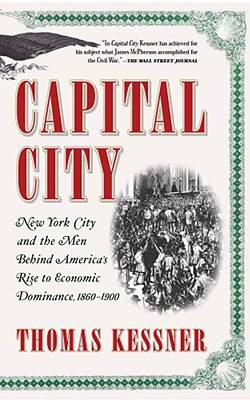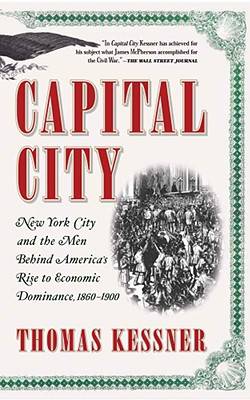
- Afhalen na 1 uur in een winkel met voorraad
- Gratis thuislevering in België vanaf € 30
- Ruim aanbod met 7 miljoen producten
- Afhalen na 1 uur in een winkel met voorraad
- Gratis thuislevering in België vanaf € 30
- Ruim aanbod met 7 miljoen producten
Zoeken
Capital City
New York City and the Men Behind America's Rise to Economic Dominance, 1860-1900
Thomas Kessner
Paperback | Engels
€ 39,95
+ 79 punten
Omschrijving
At the beginning of the nineteenth century, New York City was an undistinguished town, competing with Philadelphia and Boston to be America's dominant port city. Just two generations later, it had built itself into the country's powerhouse center of trade and finance, rivaled only by London as financial capital of the world. In Capital City, Thomas Kessner tells the story of this remarkable transformation.
With the advantages of its famous harbor and the opening of the Erie Canal in 1825, New York became the chief commercial center for the growing nation. As the shipping industry prospered, capital accumulated, and a growing banking center emerged, New York went on to finance the Union cause during the Civil War, open the West to development, and consolidate the national railroad system. The city's energy and opportunity attracted ambitious men from all over the country whose names became synonymous with big business: Vanderbilt, Carnegie, Rockefeller, and Morgan. New York's banks set the interest rates for the nation, its stock exchange fixed the price of securities, its investors transformed American business from family-owned enterprises into modern corporations, and its growing political clout catapulted public figures, such as Samuel Tilden and Teddy Roosevelt, onto the national stage.
Combining political and urban history with a colorful cast of characters, Capital City chronicles how Gotham's Gilded Age reshaped the metropolis and the nation as it molded our present-day economy.
With the advantages of its famous harbor and the opening of the Erie Canal in 1825, New York became the chief commercial center for the growing nation. As the shipping industry prospered, capital accumulated, and a growing banking center emerged, New York went on to finance the Union cause during the Civil War, open the West to development, and consolidate the national railroad system. The city's energy and opportunity attracted ambitious men from all over the country whose names became synonymous with big business: Vanderbilt, Carnegie, Rockefeller, and Morgan. New York's banks set the interest rates for the nation, its stock exchange fixed the price of securities, its investors transformed American business from family-owned enterprises into modern corporations, and its growing political clout catapulted public figures, such as Samuel Tilden and Teddy Roosevelt, onto the national stage.
Combining political and urban history with a colorful cast of characters, Capital City chronicles how Gotham's Gilded Age reshaped the metropolis and the nation as it molded our present-day economy.
Specificaties
Betrokkenen
- Auteur(s):
- Uitgeverij:
Inhoud
- Aantal bladzijden:
- 416
- Taal:
- Engels
Eigenschappen
- Productcode (EAN):
- 9780743257534
- Verschijningsdatum:
- 7/04/2004
- Uitvoering:
- Paperback
- Formaat:
- Trade paperback (VS)
- Afmetingen:
- 141 mm x 217 mm
- Gewicht:
- 535 g

Alleen bij Standaard Boekhandel
+ 79 punten op je klantenkaart van Standaard Boekhandel
Beoordelingen
We publiceren alleen reviews die voldoen aan de voorwaarden voor reviews. Bekijk onze voorwaarden voor reviews.











